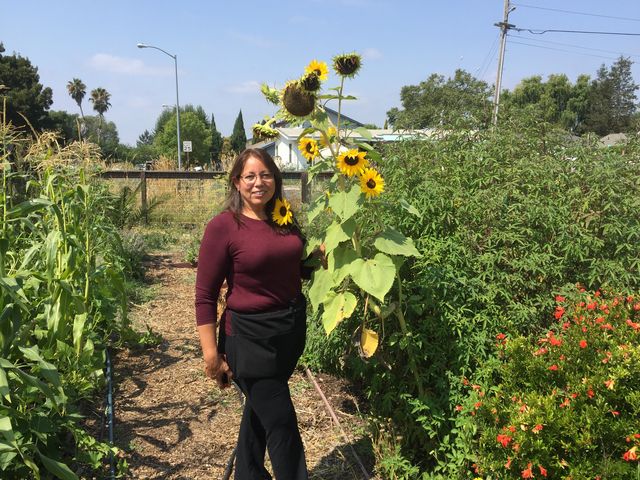On average, residents of Southwest Santa Rosa have poorer health outcomes than their neighbors in more affluent sections of the city. According to the Santa Rosa Press Democrat, a 2014 report published by the Sonoma County Department of Health Services, found that Roseland had a lower human development index than the state of Mississippi, which is ranked lowest in the nation. Human development indices are based on a number of factors including health, income and education.
As part of our continuing coverage of health in Roseland, KRCB’s Adia White attended a class called “Cultivating for Health” at Bayer Neighborhood Park and Gardens. She has more on  Maria de los Angeles Quiñones stands in the medicinal herb garden at Bayer Farms. Photo Credit: Adia Whitehow this group is taking control of their health by growing, preparing and using medicinal plants.
Maria de los Angeles Quiñones stands in the medicinal herb garden at Bayer Farms. Photo Credit: Adia Whitehow this group is taking control of their health by growing, preparing and using medicinal plants.
This report is part of our ongoing partnership with radio station KBBF. It is supported by a grant from the USC-Annenberg Center for Health Journalism Impact Fund.
Escucha en Español/Listen in Spanish
En promedio, los residentes del suroeste de Santa Rosa tienen peores resultados de salud que sus vecinos en las secciones más prósperas de la ciudad.
De acuerdo con Santa Rosa Press Democrat, un informe de 2014 publicado por el Departamento de Servicios de Salud del Condado de Sonoma, encontró que Roseland tenía un índice de desarrollo humano más bajo que el estado de Mississippi, que ocupa el puesto más bajo en la nación.
Los índices de desarrollo humano se basan en una serie de factores que incluyen la salud, los ingresos y la educación.
Como parte de nuestra cobertura continua de salud en Roseland, Adia White de KRCB asistió a una clase llamada "Cultivación para La Salud" en Bayer Neighborhood Park and Gardens. Ella tiene más información sobre cómo este grupo toma el control de su salud mediante el cultivo, la preparación y el uso de plantas medicinales.
Este informe es parte de nuestra asociación continua con la estación de radio KBBF. Cuenta con el apoyo de una subvención del Fondo de Impacto del Centro de USC-Annenberg para Periodismo de Salud.
(María de los Ángeles Quiñones se encuentra en el jardín de hierbas medicinales en Bayer Farms. Crédito de foto: Adia White)
In East Chicago, Indiana, authorities built a public housing project on land once occupied by a lead smelting operation. The area has been declared a Superfund site, and residents of the housing project, but not the surrounding area, have been moved. After we produced this episode of our podcast, the housing project was torn down.
 Nevertheless, in the summer of 2018, revelations have continued about inaccurate and misleading information provided to community residents by officials, who hid the health impact of the buried lead in their neighborhood.
Nevertheless, in the summer of 2018, revelations have continued about inaccurate and misleading information provided to community residents by officials, who hid the health impact of the buried lead in their neighborhood.
(photo: Calumet Lives Matter president Sherry Hunter, left, sports her group's signature shirt at the independent Community Strategy Group's Calumet Day table with Rev. Cheryl Rivera. Photo credit: Annie Ropeik for Indiana Public Broadcasting Stations.)
Annie Ropeik and Nick Janzen followed this story for two years when they worked together at Indiana Public Broadcasting, and were part of a team that won several awards for its coverage.
Here's the first episode of Living Downstream: the Environmental Justice Podcast. Subscribe on iTunes, or wherever you get your podcasts (coming soon!)
Read more about Annie Ropeik and Nick Janzen.
Read a 2011 report (PDF) from the U.S. Department of Health and Human Services about the lead smelting operation in East Chicago and the contamination left behind.
Below: watch a discussion between East Calumet resident Akeeshea Daniels and reporter Annie Ropeik from the project "Blood Lead and Soil: A Year in East Chicago" produced by Indiana Public Broadcasting.

 Live Radio
Live Radio